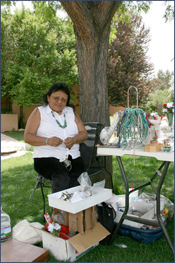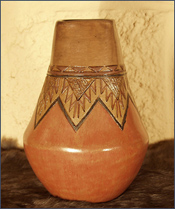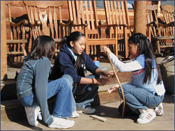Peoples of the Mesa Verde Region
Today: Mid-1900s to the PresentNavajo

Many Navajos rely on income from the sale of their handmade rugs and jewelry, which are highly collectible. (See enlarged photograph.) With a 27,000-square-mile reservation and more than 250,000 members, the Navajo Tribe is the largest American Indian tribe in the United States today. Although only a small portion of their reservation extends north of the San Juan River, Navajos consider the Mesa Verde region part of their larger world because it lies within the area bounded by the four sacred mountains. More than 1,000 Navajo live, off-reservation, in the region today. Most Navajos speak English and participate in the broader American economy, but they have also maintained their own language, customs, and religion. When traveling through Navajo country, it is not uncommon to see traditional hogans, sometimes standing next to modern houses, or sheepherders on horseback tending their flocks on the open range. The manufacture of handmade crafts, including jewelry and rugs, for sale to collectors and tourists remains an important industry in the twenty-first century. In addition, many Navajos are employed in area government, schools, and businesses, as well as in the oil and gas industries. 
Former World War II Navajo Code Talkers at a 2007 reunion in Window Rock, Arizona. On the southern edge of the Mesa Verde region, the Shiprock campus of Diné College offers Navajo students the opportunity to study their history, language, and culture, as well as obtain a variety of degrees and certifications. |
|
Acknowledgments | Illustration credits | To borrow, cite, or request permission | Please take our survey! Title page for Peoples of the Mesa Verde Region |
|
 DONATE TODAY
DONATE TODAY



